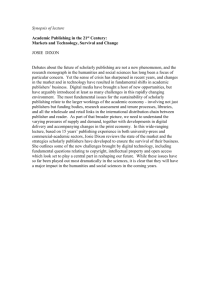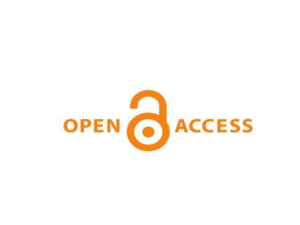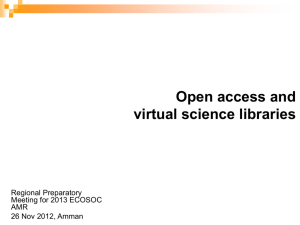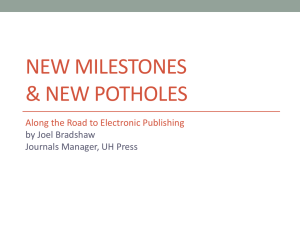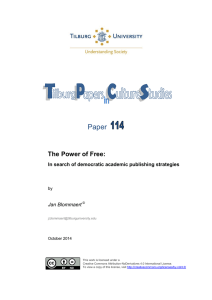Slides - University of Sussex
advertisement
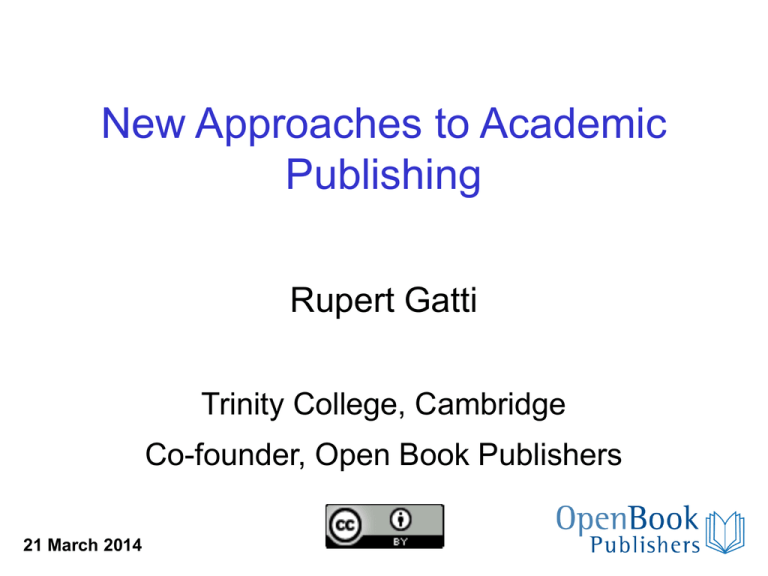
New Approaches to Academic Publishing Rupert Gatti Trinity College, Cambridge Co-founder, Open Book Publishers 21 March 2014 What is Open Access? •Free to read online •Free to share a digital edition •Free to reuse (subject only to author attribution) Ref: http://www.budapestopenaccessinitiative.org/read Green & Gold OA Green OA A final copy of the published work is available under an OA licence from a repository. •There is no requirement for an embargo period. Gold OA The published edition of the work is available under an OA licence. •There is no requirement for an apc. Some examples Green OA arXive (Institutional funding) 900k e-prints in Physics, Mathematics, Computer Science, Quantitative Biology, Quantitative Finance and Statistics founded 1991 <http://arxiv.org/> PubMed Central (Public funding) 3 million articles in biomedical and life sciences NIH Public Access Policy <http://www.ncbi.nlm.nih.gov/pmc/> Gold OA PLOS (apc) PLOS One – published 33k articles in 2013 Different ‘acceptance’ standard <http://www.plos.org/> AHRC (UK) Data Discipline Books Chapters Journal Other (%) (%) Articles (%) (%) English 39 27 31 3 French 37 23 39 1 Philosophy 14 20 65 1 Sociology 22 10 64 3 Law 18 15 65 1 Politics 29 9 62 0 Economics 1 2 89 7 Chemistry 0 0 100 0 Proportions of output types in a sample of RAE 2008 submissions Source: Nigel Vincent “The monograph challenge” in N. Vincent & C. Wickham (eds) Debating Open Access, British Academy 2013. (p. 106) <https://www.britac.ac.uk/openaccess/debatingopenaccess.cfm> Journals •Many thousands of Gold OA journals exist in the humanities. •The vast majority make NO charge on authors to publish. •Within HSS, apc's are important for the 'legacy' and the 'predatory' publishers. Some Data http://www.doaj.org/ •9,763 Journals listed from 141 countries 6,527 (2/3) make no author charges About 45% are in HSS Humanities data Literature: 672 journals 55 languages (498 in English) 67 countries (Brazil 84, USA 81, UK 29) 625 (93%) have no charges, 37 with charges •History: 238 journals 28 languages (141 in English) 35 countries (Brazil 37, USA 28, UK 8) 223 (94%) have no charges, 9 with charges Published by Universities (50%), Research Institutes (20%) and Societies (15%) Business Models •apc model small in Humanities •Academics input •University/Institutional support –the entire internet developed that way •Open infrastructure – vitally important –Open Journal Systems (http://pkp.sfu.ca/ojs/) –Open Edition – revues.org (www.openedition.org) –Directory of Open Access Journals No mega journals / repositories •No equivalents of –PloS (apc), –arXive (institutional), –PubMed Central (public funding), –PeerJ (membership) •Open Library of the Humanities <https://www.openlibhums.org/> –library subscription Books •The existing publishing model is broken –high prices (£50) & low sales (300) –financial model: relies on DENYING access to knowledge – at a time when HSS is fighting for recognition and funding we have a system where almost all our research is inaccessible to anyone beyond an elite few. •This has nothing to do with Open Access, this is where the publishing industry, and academia, has led itself. •Open Access is potentially a saviour – not a threat – for HSS Opportunities •Broader readership •Reader interaction •Multi-media publications •Relating research and primary sources •Reuse of publications •Innovation in research & dissemination http://www.doabooks.org/ http://books.openedition.org/ 1662 books 55 publishers Languages: English (909) German (319) Italian (93) French (16) Spanish (2) Portuguese (0) 1161 books 33 publishers Languages: French (959) English (118) Spanish (72) Italian (11) Portuguese (0) Published 2013-14: 185 books Published 2013-14: 46 books Broader Readership OBP Online Readers 18 Jan – 18 Feb 2014 OBP Reader 7,349 Google Books 7,512 Total Online Readers 14,861 Av per title in month 391 133 countries UK 25% USA 20% Algeria 6% Reader Interaction Having full text available online enables readers to comment on and add to the work. •Ingo Gildenhard - Cicero, Against Verres, 2.1.53–86 (OBP) Uploaded to The Classics Library (http://inverrem2_1.theclassicslibrary.com/) •Kathleen Fitzpatrick - Planned Obsolescense (NYU) http://mcpress.media-commons.org/plannedobsolescence/ •Kristen Nawrotzki and Jack Dougherty - Writing History in the Digital Age (UMichiganPress) http://writinghistory.trincoll.edu/ All three use free WordPress plugins Multimedia Publications Born Digital research output – incorporating, text, video, audio and web applications. •Digital resources can be linked to and integrated with the ‘publication’ •Allows new ways of presenting research findings •Reader can order/structure content as required http://scalar.usc.edu/ http://scalar.usc.edu Alternative Funding Models Institutional Support Athabasca University Press, ANU Press Research Centre & Society Partnerships WOLP, IES, CREATe Research Funding Subsidy Wellcome Trust, Max Planck Society Library Expenditure OpenEditions, Open Library of the Humanities, Knowledge Unlatched, Unglue.it Direct Publication Charges legacy publishers: Palgrave Macmillan, SpringerOpen .... Next steps: Enabling a diverse OA publishing ecology The publishing cycle: Step 1: The text Print on Demand, typesetting software (not OA), competitive market for services Step 2: The published work This is dominated by publisher provision Need: Libraries take an active role to facilitating this process Step 3: The reader Need: Universal standards/protocols to facilitate creation of broadly applicable tools to prevent publisher hijack Step 4: (Re)use Need: Publisher independent methods for assessing, archiving etc new media formats Libraries/funders need to recognise the important role they can take in providing platforms and developing standards to create an architecture which allows competitive publishing initiatives to operate. Incentives are all wrong if this left to publishers to provide and (so) control.
